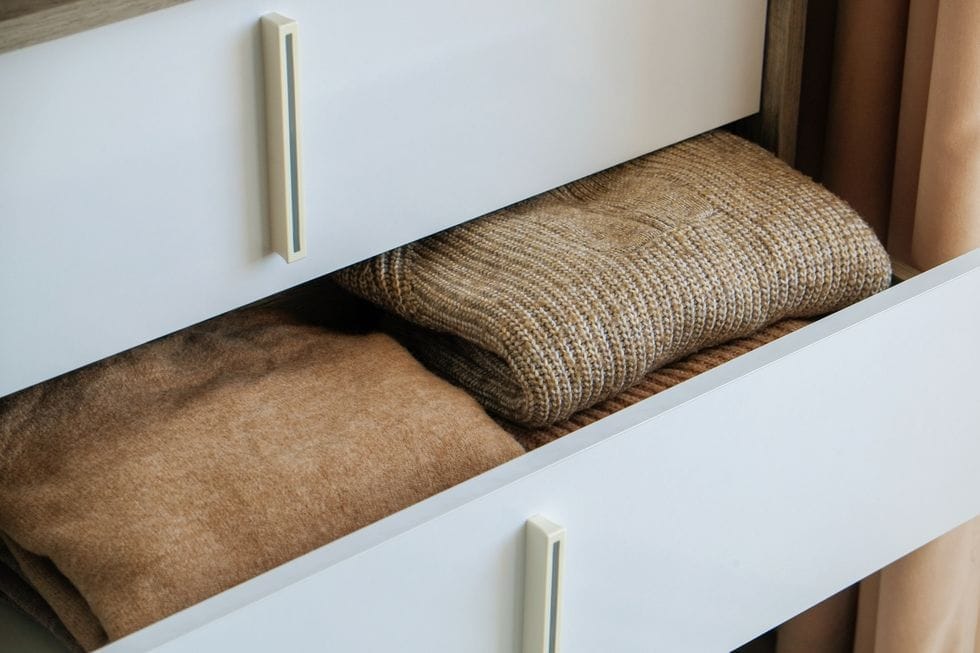
JEREMY MOELLER//GETTY IMAGES
Words by Jessica Davis
Make sure your favourite jumpers stay in pristine condition, and consequently, make your wardrobe investments go further
Investing in good quality cashmere isn’t cheap, but it’s so worth it. After buying your dream cashmere piece – whether that’s an everyday jumper, cosy coat or luxury cashmere lounge set – it’s worth paying close attention to how to care for it; that way it lasts longer, doesn’t spoil and retains that ‘just-bought’ feeling.
Whenever we invest in it as part of our forever wardrobe, maximising longevity is one of the most sustainable approaches to take when consciously shopping. As cashmere’s production takes great care and time, the price point is significantly higher than other knitwear pieces. So, it’s only natural that you want to make sure you’re preserving your investment buys for as long as possible, to pass down through generations. After all, that’s the most sustainable way we can keep consuming fashion.
“Cashmere is the under-fleece of cashmere goats, which keeps them warm in very cold winters in places like Mongolia and northern China, but is moulted each spring,” Chris Gaffney, chief executive at Johnstons of Elgin, previously told Bazaar. “The fibre is collected in March to May each year and sent to be de-haired, a process that separates any longer ‘guard hairs’ from the very fine cashmere.”
He continues: “A very small amount of cashmere can be harvested from each goat in the spring: as little as 120-250g of clean, dehaired fibre. This makes it relatively rare, and therefore precious.”
Below, cashmere designers and experts in wardrobe care share their tips on how to make your cashmere last longer, correct ways to store and how to give your tired pieces new life.
Rules for machine and hand washing
“Cashmere is a water-loving material, and your cashmere garments should be hand washed regularly after it has been worn a few times. Washing your cashmere makes it even softer and thicker,” according to cashmere brand Barrie.

JEREMY MOELLER//GETTY IMAGES
“When washing fabrics like cashmere or wool, you need to use a detergent that is specially made for protein-based materials,” says Steamery’s CEO Frej Lewenhaup; try out the brand’s Delicate Laundry Detergent which is perfect for the job. “Whether you wash by hand or in a washing machine, it’s important to wash at a low temperature that’s no higher than 20 degrees, as the combination of heat and movement will cause wool to shrink.”
Nomadic cashmere brand Oyuna echoes the importance of washing on a cold wash, but says your hair shampoo will do the job just fine. “As cashmere is an organic matter, the same as your hair, a good organic natural shampoo you’d use for yourself is perfect for it,” says designer Oyuna Tserendorj. “Let your cashmere soak in the warm shampoo water, then softly wash by hand. Rinse in clean warm water and gently squeeze it out.”
Is it safe to iron your cashmere? Barrie says pieces can be gently ironed at a low temperature, using a steam iron and hovering it over your item without completely pressing down.
How to dry cashmere effectively
“Let your cashmere garments flat dry on a towel to help preserve their shape, notes Lewenhaup. “Straighten out the collars, hems, and cuffs while the fabric is still wet. To flat dry, roll the garment in a terry cloth towel to release water and lay it out on a flat surface to air dry, flipping it over occasionally to speed up the process.”
“Cashmere loves natural light,” adds Tserendorj. “The best way to dry cashmere is in natural light, even in direct sunlight, turned inside out. It can be dried flat on a towel or simply hung on a drying rack if it’s washed in the right way.”
Fold, don’t hang when storing
“Cashmere items are best stored folded as they can lose their shape when hung,” advises Lewenhaup. “Be sure to steam or wash your garments before storing them since dirty clothes can attract pests like moths or fur beetles. For more long-term seasonal storage, vacuum bags can be a good way to save space and to keep out vermin, dust, and moisture.”
“Make sure your cashmere is clean and does not have any food or other smells to which moths are attracted to,” says Tserendorj. “Store it in a place that sees natural light or gets opened often, with several lavender sachets or cedar blocks tucked in between layers and on top.”

EVRYMMNT//GETTY IMAGES
Piling and keeping in check
“Cashmere is a natural material,” the designer continues. “It loves fresh air and sun, which gives your cashmere a refresh. You can also either put your cashmere in a freezer for a day or so, or simply put it on a warm radiator, to refresh it.”
Investing in a steamer is also a great way to give your cashmere items new life, without actually having to wash them. “The hot steam removes wrinkles, kills bacteria and rejuvenates the fabric,” Lewenhaup says. “You can also revive your cashmere items seasonally with the help of a fabric shaver.”
When buying, invest in the highest percentage
“Customers should spend some time reading about the brand, particularly where and how they source cashmere,” notes designer Oyuna. “Buying into the right brand they might support a right cause and invest in a cool yet timeless piece.”
“Check the label to see if it’s 100 per cent cashmere or a fibre blend,” adds Steamery’s Lewenhaup, “Higher percentages of cashmere generally indicate better quality. Keep in mind that cashmere items will pill naturally, which can look worn out, but pilling is completely natural and not necessarily an indicator of bad quality.”
This article originally appeared in harpersbazaar.com/uk



